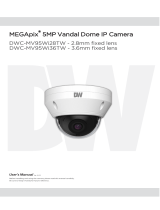
Table of Contents
1 Introduction ............................................................................................................................................................................................................. 2
2 Web Access and Login .............................................................................................................................................................................................. 3
3 Live View.................................................................................................................................................................................................................. 5
4 Camera Configuration .............................................................................................................................................................................................. 7
4.1 System Configuration .............................................................................................................................................................. 7
4.1.1 System Information .................................................................................................................................................... 7
4.1.2 Date and Time ............................................................................................................................................................. 7
4.1.3 Local Recording ........................................................................................................................................................... 7
4.1.4 Storage ........................................................................................................................................................................ 8
4.2 Video Configuration ..............................................................................................................................................................10
4.2.1 Image Configuration .................................................................................................................................................10
4.2.2 Video / Audio Configuration .....................................................................................................................................12
4.2.3 OSD Configuration ....................................................................................................................................................13
4.2.4 Video Mask ...............................................................................................................................................................13
4.2.5 ROI Configuration .....................................................................................................................................................14
4.2.6 Zoom/Focus ..............................................................................................................................................................15
4.3 Alarm Setup ..........................................................................................................................................................................15
4.3.1 Motion Detection .....................................................................................................................................................15
4.3.2 Other Alarms .............................................................................................................................................................17
4.3.3 Alarm In (Sensor Input) .............................................................................................................................................18
4.3.4 Alarm Out .................................................................................................................................................................19
4.3.5 Alarm Server .............................................................................................................................................................20
4.4 Analytics Configuration .........................................................................................................................................................20
4.4.1 Object Removal .........................................................................................................................................................20
4.4.2 Exception ..................................................................................................................................................................22
4.4.3 Line Crossing .............................................................................................................................................................23
4.4.4 Intrusion ....................................................................................................................................................................24
4.4.5 Face Detection ..........................................................................................................................................................26
4.4.6 Region Entrance ........................................................................................................................................................28
4.4.7 Region Exiting ...........................................................................................................................................................29
4.4.8 Target Counting .........................................................................................................................................................29
4.4.9 Region Statistics ........................................................................................................................................................31
4.4.10 Heat Map ..................................................................................................................................................................33
4.5 Network Configuration .........................................................................................................................................................34
4.5.1 TCP/IP ........................................................................................................................................................................34
4.5.2 Port ...........................................................................................................................................................................35
4.5.3 Server Configuration .................................................................................................................................................36
4.5.4 Onvif..........................................................................................................................................................................36
4.5.5 DDNS .........................................................................................................................................................................37
4.5.6 SNMP ........................................................................................................................................................................37
4.5.7 802.1x .......................................................................................................................................................................38
4.5.8 RTSP ..........................................................................................................................................................................39
4.5.9 RTMP .........................................................................................................................................................................39
4.5.10 UPNP .........................................................................................................................................................................40
4.5.11 Email .........................................................................................................................................................................40
4.5.12 FTP ............................................................................................................................................................................40
4.5.13 HTTPS ........................................................................................................................................................................41
4.5.14 QoS............................................................................................................................................................................42
4.6 Security Configuration ..........................................................................................................................................................42





















